- Benefits of Growing Kohlrabi
- 1. Nutritional Value
- 2. Easy to Grow
- 3. Versatility in the Kitchen
- 4. Storage and Shelf Life
- 5. Pest and Disease Resistance
- 6. Companion Planting
- 7. Different Varieties to Choose From
- Choosing the Right Varieties of Kohlrabi
- Planting Kohlrabi Seeds or Transplants
- Planting Kohlrabi Seeds:
- Transplanting Kohlrabi Seedlings:
- Caring for Kohlrabi Plants
- Watering
- Fertilizing
- Weeding
- Pest Control
- Disease Prevention
- Harvesting
- Storing
- Conclusion
- Harvesting and Storing Kohlrabi
- Harvesting Tips
- Storing Kohlrabi
- Common Pests and Diseases of Kohlrabi
- Pests
- Diseases
- Delicious Recipes Using Kohlrabi
- Kohlrabi Slaw
- Roasted Kohlrabi Fries
- Kohlrabi and Apple Salad
- Kohlrabi and Potato Curry
- Kohlrabi and Carrot Soup
- “Question-Answer”
- What is kohlrabi?
- How do you grow kohlrabi?
- What are some popular varieties of kohlrabi?
- Can kohlrabi be grown in containers?
- What are some tips for growing kohlrabi?
- How long does it take for kohlrabi to mature?
- What are some pests and diseases that affect kohlrabi?
- “Video” The 10 Most Productive Crops to Sow in July
When it comes to growing vegetables in your garden, kohlrabi is a unique and delicious choice. This versatile plant is a member of the cabbage family and is known for its bulbous, turnip-like stem.
There are several varieties of kohlrabi to choose from, each with its own distinct flavor and color. The most common varieties include White Vienna, Purple Vienna, and Grand Duke. White Vienna is the most popular variety and has a mild, sweet flavor, while Purple Vienna has a more intense taste and vibrant purple color. Grand Duke is known for its large and tender stems.
Kohlrabi is a cool-season vegetable that is best grown in early spring or fall. It prefers full sun, but can tolerate partial shade. The soil should be well-draining and rich in organic matter. It is important to provide regular watering, as kohlrabi requires consistent moisture to grow properly.
To plant kohlrabi, sow the seeds directly into the garden about ¼ inch deep. Space them about 6-8 inches apart to allow room for growth. Thin the seedlings to the strongest plant in each space. Kohlrabi plants will mature in about 55-60 days, and the bulbs are ready to harvest when they reach 2-3 inches in diameter.
Kohlrabi can be eaten raw or cooked, and its mild, slightly sweet flavor makes it a versatile ingredient in a variety of dishes. It can be sliced and added to salads, roasted or steamed as a side dish, or even used as a substitute for potatoes in mashed kohlrabi. Its leaves are also edible and can be cooked like spinach or used in stir-fries.
So, whether you are a seasoned gardener or just starting out, consider adding kohlrabi to your vegetable garden. With its unique flavor and easy cultivation, it is sure to become a favorite in your kitchen.
Benefits of Growing Kohlrabi
Kohlrabi is a versatile and nutritious vegetable that offers many benefits when grown in the garden. Here are some of the advantages of growing kohlrabi:
1. Nutritional Value
Kohlrabi is rich in essential nutrients such as vitamin C, vitamin B6, potassium, and fiber. It is low in calories and fat, making it a healthy addition to any diet.
2. Easy to Grow
Kohlrabi is a relatively easy vegetable to grow, making it suitable for both beginner and experienced gardeners. It can be grown from seeds or transplants and has a short growing period, typically taking around 50-60 days from planting to harvest.
3. Versatility in the Kitchen
Kohlrabi can be prepared and enjoyed in various ways. It can be eaten raw, sliced or grated, and added to salads for a crunchy texture. It can also be cooked and used in stir-fries, soups, or roasted as a side dish. Additionally, the leaves of the kohlrabi plant are edible and can be used in cooking similar to other leafy greens.
4. Storage and Shelf Life
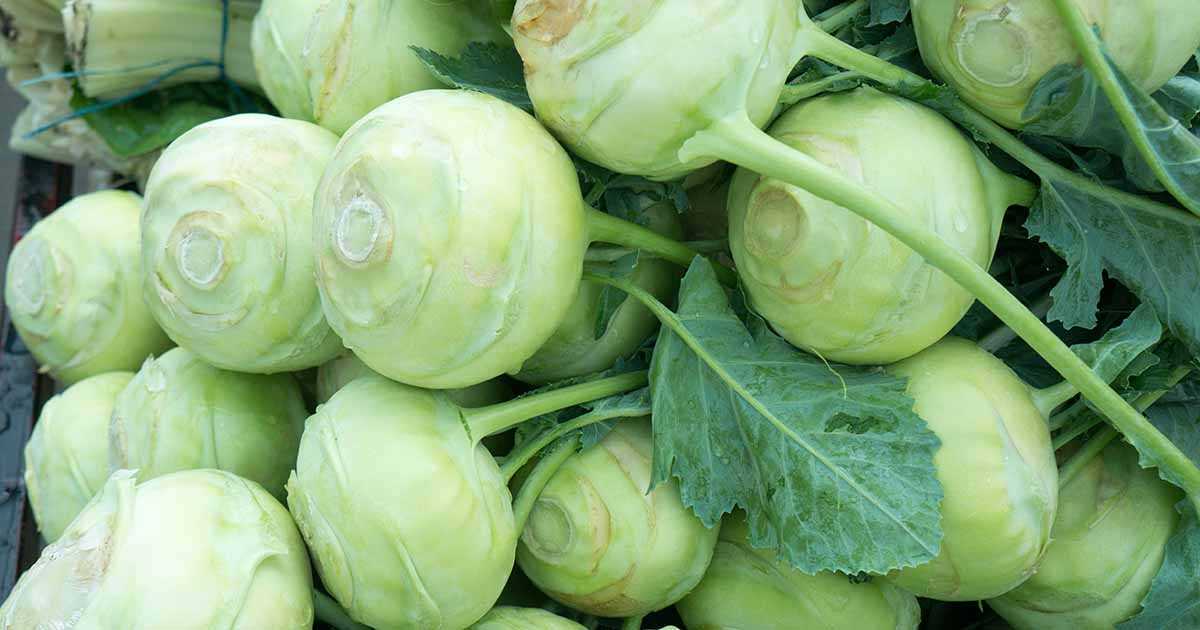
Kohlrabi has a decent shelf life compared to other vegetables, making it a convenient choice for gardeners. After harvesting, kohlrabi can be stored in the refrigerator for up to several weeks. This allows you to enjoy the fresh taste and nutritional benefits of kohlrabi for an extended period.
5. Pest and Disease Resistance
Kohlrabi plants are generally resistant to many common garden pests and diseases. This reduces the need for extensive pesticide or chemical treatments, making it an environmentally friendly choice for gardeners.
6. Companion Planting
Kohlrabi can be grown alongside other vegetables as part of a companion planting strategy. It is known to be compatible with plants such as lettuce, spinach, and onions, helping to enhance growth and repel pests.
7. Different Varieties to Choose From
Kohlrabi comes in different varieties, each with its unique flavor and appearance. From the traditional green kohlrabi to the purple and white varieties, there is something for every taste and preference.
Overall, growing kohlrabi in the vegetable garden offers numerous benefits, from its nutritional value and ease of cultivation to its versatility in the kitchen. Consider adding kohlrabi to your garden to enjoy these advantages and explore the many ways this vegetable can enhance your meals.
Choosing the Right Varieties of Kohlrabi
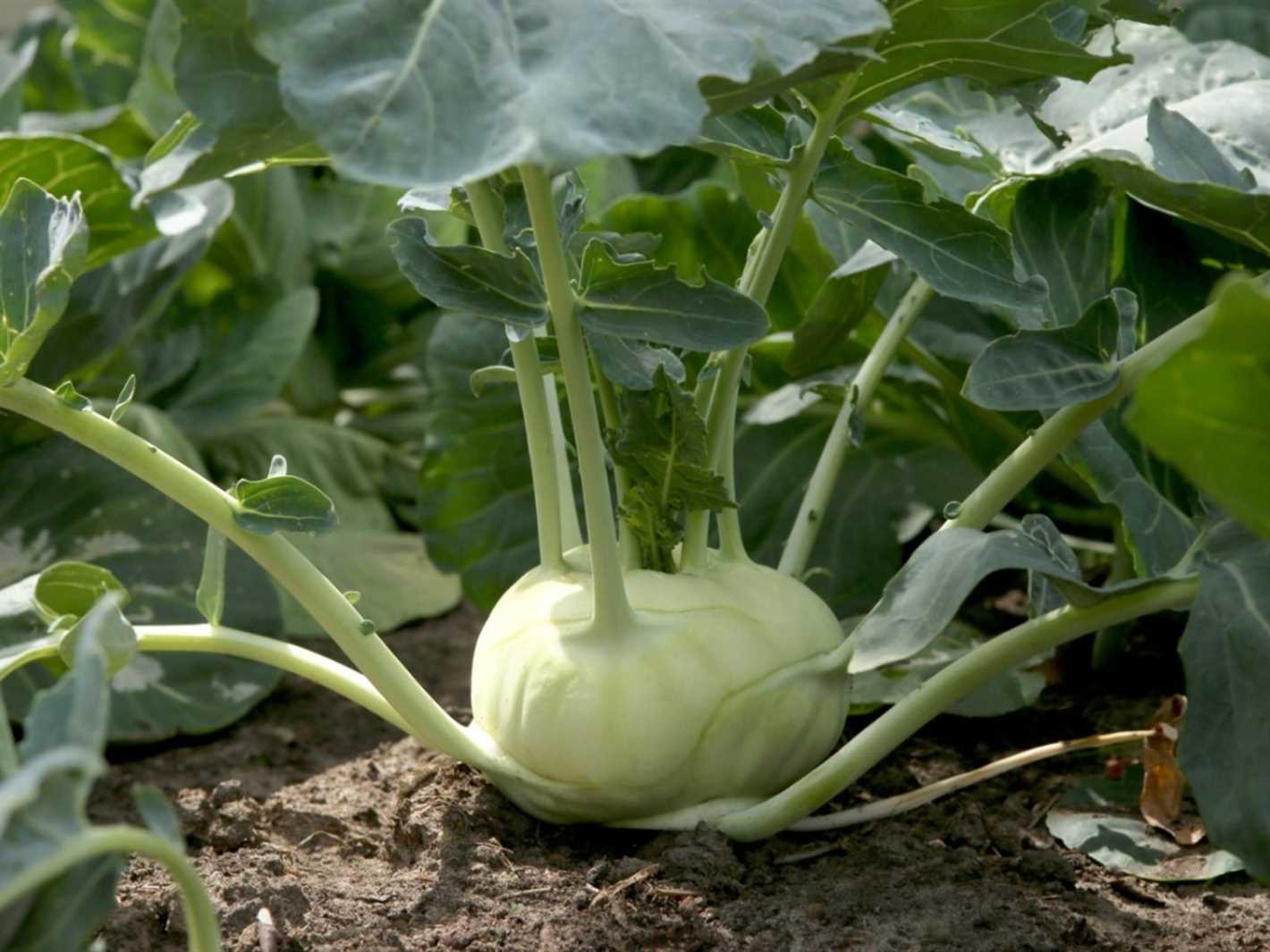
Kohlrabi is a versatile vegetable that comes in a variety of shapes, sizes, and colors. When choosing the right variety of kohlrabi to grow in your vegetable garden, consider the following factors:
- Size: Kohlrabi varieties can range in size from small to large. Choose a size that suits your preference and cooking needs. Smaller varieties are ideal for snacking and salads, while larger varieties are better suited for cooking and roasting.
- Color: Kohlrabi can be green or purple in color. Consider the color you prefer and choose a variety accordingly. Green kohlrabi is more common and has a milder flavor, while purple kohlrabi tends to have a slightly sweeter taste.
- Texture: Some kohlrabi varieties have a smooth texture, while others have a more wrinkled or bumpy appearance. The texture can affect the cooking experience and the final dish. If you plan to use kohlrabi in salads or slaws, opt for a smoother variety. If you’re planning to roast or sauté the vegetable, a bumpy variety may add more texture and interest to the dish.
- Growing season: Different kohlrabi varieties have varying maturation times. Some varieties mature faster and can be harvested in as little as 40 days, while others may take up to 60-70 days. Consider your local climate and growing season length when choosing a variety to ensure a successful harvest.
Here are a few popular varieties of kohlrabi to consider:
| Name | Color | Size |
|---|---|---|
| Early White Vienna | Green | Small to medium |
| Gigante | Purple | Large |
| Kolibri | Green | Small |
| Purple Delicacy | Purple | Medium |
Ultimately, the choice of kohlrabi variety will depend on your personal preferences and the specific dishes you plan to make. Experiment with different varieties to find the ones that work best for you and enjoy the unique flavor and texture that kohlrabi brings to your vegetable garden.
Planting Kohlrabi Seeds or Transplants
Planting kohlrabi can be done either by sowing seeds directly into the garden or by transplanting seedlings. Here are the steps to successfully plant kohlrabi seeds or transplants:
Planting Kohlrabi Seeds:
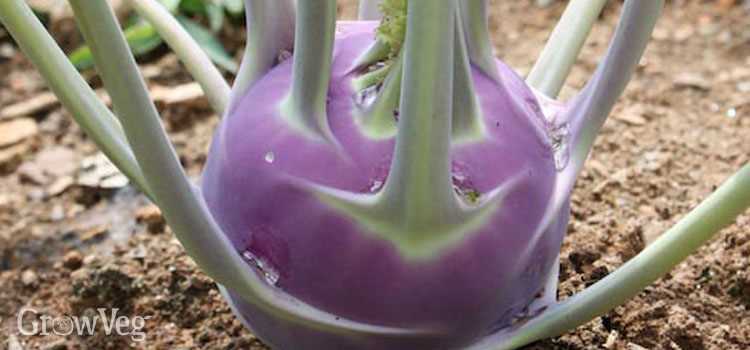
- Prepare the soil by loosening it to a depth of about 6 inches (15 cm) and removing any weeds.
- Mix in some compost or well-rotted manure to improve the soil’s fertility.
- Sow kohlrabi seeds directly into the prepared soil, spacing them about 4-6 inches (10-15 cm) apart.
- Plant the seeds about 1/4 inch (6 mm) deep, and cover them with soil.
- Water the seeds gently to avoid washing them away or causing soil compaction.
- Keep the soil consistently moist until the seeds germinate, which typically takes 7-10 days.
- Thin the seedlings to ensure they have enough space to grow. Leave the strongest seedling in each planting spot and remove the weaker ones.
Transplanting Kohlrabi Seedlings:
- If you are starting kohlrabi indoors, sow the seeds in biodegradable pots or seed trays filled with seed starting mix about 4-6 weeks before the last frost date.
- Keep the seedlings in a warm and well-lit area, and water them regularly.
- Transplant the seedlings outdoors when they have developed 4-6 true leaves and the soil has warmed up.
- Choose a planting spot with well-drained soil and full sun or partial shade.
- Dig a hole for each seedling, spacing them about 4-6 inches (10-15 cm) apart.
- Carefully remove the seedling from its container, being careful not to disturb the roots too much.
- Place the seedling in the hole and fill it with soil, making sure the plant is at the same depth as it was in the container.
- Water the transplants thoroughly to help them establish in the garden.
By following these steps, you can successfully plant kohlrabi seeds directly into the garden or transplant seedlings for easier and quicker growth. Enjoy fresh kohlrabi in your vegetable garden!
Caring for Kohlrabi Plants
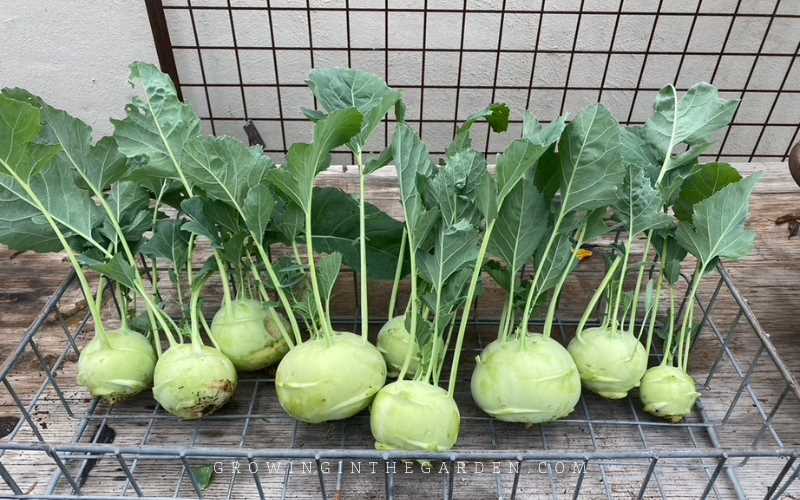
Watering
Kohlrabi plants require regular watering to keep the soil consistently moist. The plants should be watered deeply, allowing the water to soak into the root zone. However, it is important to avoid over-watering, as this can lead to root rot. Watering should be done in the morning to allow any excess moisture to evaporate throughout the day.
Fertilizing
Kohlrabi plants benefit from a balanced fertilizer application before planting and throughout the growing season. A general purpose vegetable fertilizer with equal amounts of nitrogen, phosphorus, and potassium can be applied according to the manufacturer’s instructions. Fertilizer should be applied evenly around the plants, avoiding direct contact with the foliage to prevent burn.
Weeding
Regular weeding is important to keep the area around kohlrabi plants free from competition. Weeds can rob the plants of nutrients and water, reducing their overall health and productivity. Hand pulling weeds or using a hoe to remove them is an effective method of weed control. Applying a layer of mulch around the plants can also help suppress weed growth.
Pest Control
Kohlrabi plants may be susceptible to common garden pests such as aphids, cabbage worms, and flea beetles. Regularly inspect the plants for signs of pest damage, such as chewed leaves or discoloration. Insecticidal sprays or organic pest control methods can be used to manage infestations. Additionally, attracting beneficial insects like ladybugs and lacewings can help control pest populations.
Disease Prevention
Proper sanitation and disease prevention practices can help keep kohlrabi plants healthy. Avoid planting kohlrabi in areas where other brassica crops have been grown recently, as this can increase the risk of disease. Provide adequate spacing between plants to promote good air circulation, which can help prevent diseases like powdery mildew. Removing and destroying any diseased plant material can also help prevent the spread of diseases.
Harvesting
Kohlrabi plants are typically ready for harvest 55-65 days after planting. The bulbs should be harvested when they reach 2-3 inches in diameter. Using a sharp knife, cut the bulb from the stem at ground level. The leaves can also be harvested and used in cooking, similar to collard greens or kale. Harvesting the bulbs regularly will encourage new growth.
Storing
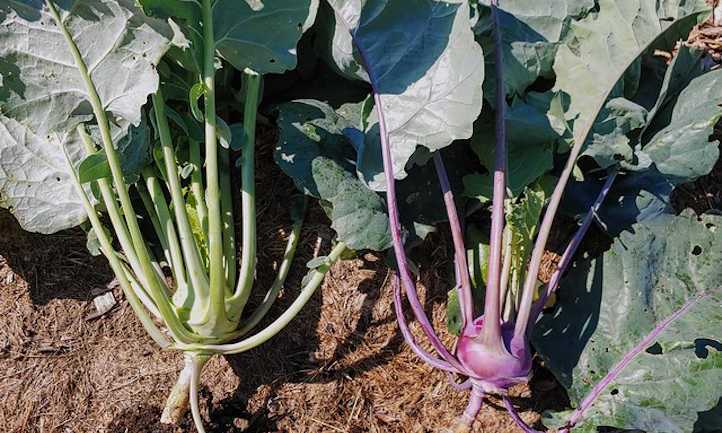
Kohlrabi bulbs can be stored in the refrigerator for up to 2 weeks. Remove the leaves from the bulbs and place them in a plastic bag or container with air holes. Store them in the vegetable crisper drawer to maintain freshness. The leaves can be stored separately in a plastic bag, but should be used within a few days.
Conclusion
Caring for kohlrabi plants involves providing adequate water, fertilization, and pest and disease control. With proper care, kohlrabi plants can produce a delicious and nutritious harvest of crunchy bulbs and flavorful leaves.
Harvesting and Storing Kohlrabi
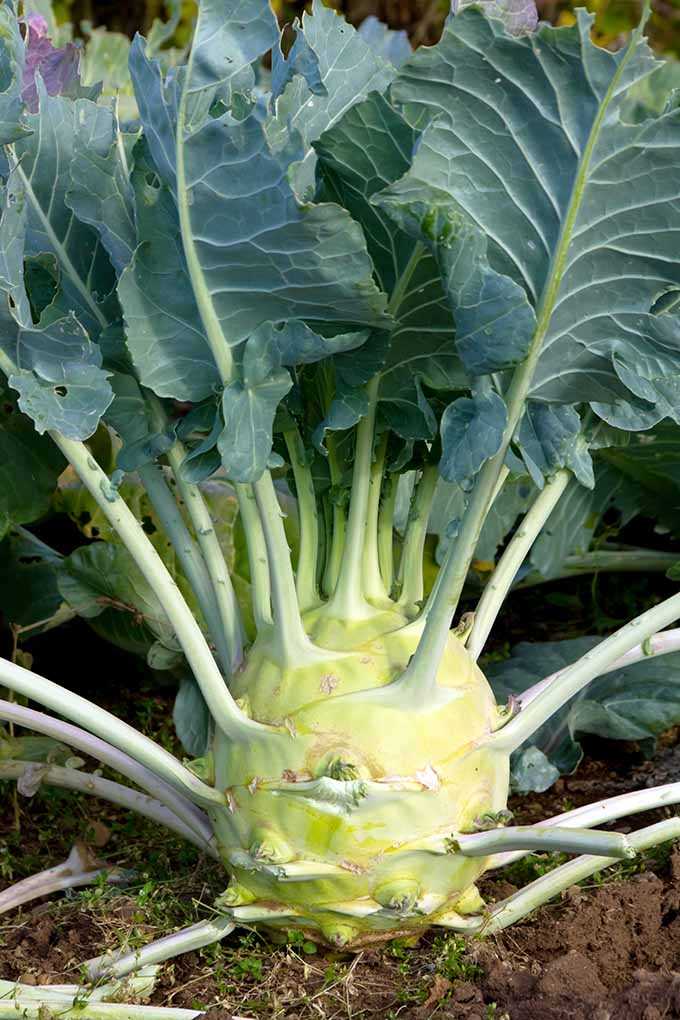
Kohlrabi can be harvested when the bulb has reached a diameter of 2-3 inches. To harvest, use a sharp knife and cut the stem of the kohlrabi just above the soil level. Be careful not to damage the root system or neighboring plants.
Harvesting Tips
- Avoid letting the kohlrabi bulbs become too large as they may become woody and lose their flavor.
- Harvest kohlrabi promptly as they can become tough and fibrous if left in the ground for too long.
- Harvest the larger bulbs first, leaving the smaller ones to continue growing.
- Inspect harvested bulbs for any signs of damage or disease. Discard any damaged bulbs.
Storing Kohlrabi
Kohlrabi can be stored in a cool and moist environment to extend its shelf life. Here are some tips for storing kohlrabi:
- Remove any excess leaves attached to the bulb, leaving about an inch of stem.
- Place the bulbs in a plastic bag and store them in the refrigerator’s crisper drawer. Ensure that the bag is sealed tightly to retain moisture.
- Kohlrabi can be stored for up to two weeks in the refrigerator.
- For longer-term storage, kohlrabi can be blanched and frozen. Simply peel and slice the bulbs, blanch them in boiling water for 2-3 minutes, then plunge them into ice water to stop the cooking process. Drain and pack the blanched kohlrabi into freezer bags, removing as much air as possible before sealing. Frozen kohlrabi can be stored for up to six months.
By following these harvesting and storage tips, you can enjoy fresh and flavorful kohlrabi throughout the season!
Common Pests and Diseases of Kohlrabi
Kohlrabi, like any other vegetable, can be susceptible to pests and diseases. Being aware of these common problems can help gardeners identify and treat them early, ensuring a healthy and productive crop.
Pests
- Aphids: These small, soft-bodied insects can be found on the undersides of leaves and can cause stunted growth and distorted leaves. Regularly inspecting the plants and spraying them with a strong stream of water or applying an insecticidal soap can help control aphids.
- Cabbage Worms: These green caterpillars can chew holes in the leaves of kohlrabi plants. Handpicking them off the plants or using Bacillus thuringiensis (BT) can help control cabbage worms.
- Flea Beetles: These small, black beetles can chew small holes in the leaves and cause stunted growth. Protecting the plants with floating row covers or applying insecticides labeled for flea beetle control can help manage this pest.
- Slugs and Snails: These slimy creatures can chew holes in the leaves and damage the edible bulb of kohlrabi. Removing debris, mulching with sharp materials like crushed eggshells or diatomaceous earth, and handpicking can help control slugs and snails.
Diseases
- Clubroot: This soil-borne disease causes the roots of kohlrabi plants to become swollen and deformed. Rotating crops, improving soil drainage, and using resistant varieties can help prevent clubroot.
- Downy Mildew: A fungal disease that causes yellow or brown patches on the leaves and a fuzzy growth on the undersides. Ensuring adequate air circulation, avoiding overhead watering, and using fungicides can help manage downy mildew.
- Blackleg: This bacterial disease causes blackened stems near the soil line and stunted growth. Planting disease-free seedlings and practicing crop rotation can help prevent blackleg.
- Powdery Mildew: A fungal disease that forms a white, powdery coating on the leaves. Providing adequate spacing between plants, avoiding overhead watering, and using fungicides can help control powdery mildew.
By being vigilant and taking steps to prevent and manage these common pests and diseases, gardeners can ensure a successful harvest of kohlrabi.
Delicious Recipes Using Kohlrabi
Kohlrabi Slaw
Kohlrabi slaw is a refreshing and crunchy side dish that pairs well with grilled meats or as a topping for tacos. Here’s a simple recipe:
- 1 medium kohlrabi, peeled and grated
- 1 carrot, peeled and grated
- 2 tablespoons mayonnaise
- 1 tablespoon lemon juice
- 1 teaspoon honey
- Salt and pepper to taste
In a bowl, combine the grated kohlrabi and carrot. In a separate small bowl, whisk together the mayonnaise, lemon juice, honey, salt, and pepper. Pour the dressing over the kohlrabi and carrot, and toss to coat. Refrigerate for at least 30 minutes before serving.
Roasted Kohlrabi Fries
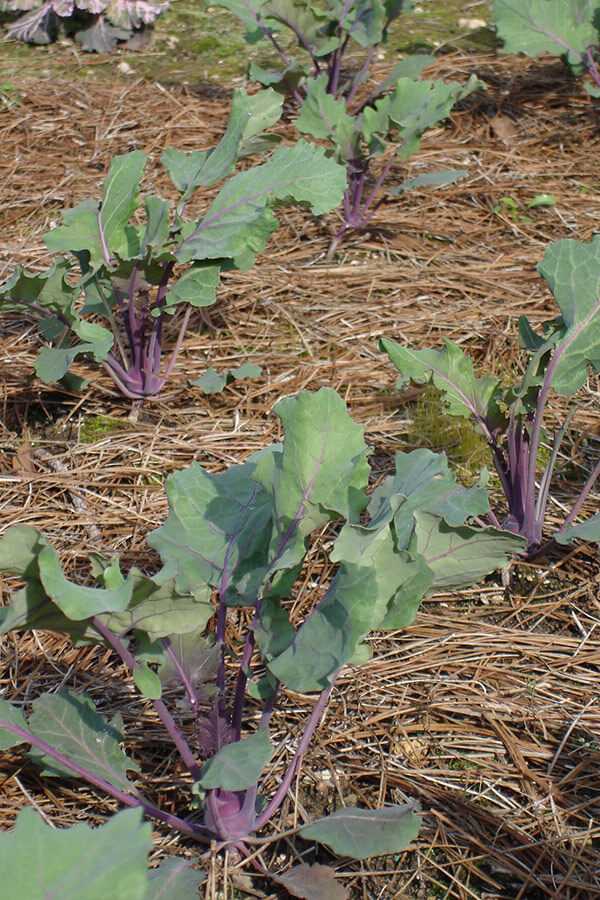
If you’re looking for a healthier alternative to traditional french fries, try making roasted kohlrabi fries. They have a similar crispy texture and go well with a variety of dipping sauces. Here’s how to make them:
- 2 kohlrabi bulbs, peeled and cut into thick matchsticks
- 2 tablespoons olive oil
- 1 teaspoon paprika
- 1/2 teaspoon garlic powder
- Salt and pepper to taste
Preheat your oven to 425°F (220°C). In a large bowl, toss the kohlrabi matchsticks with olive oil, paprika, garlic powder, salt, and pepper until well coated. Spread them out in a single layer on a baking sheet lined with parchment paper. Roast for 20-25 minutes, flipping halfway through, until the fries are golden brown and crispy. Serve immediately.
Kohlrabi and Apple Salad
This light and refreshing salad combines the crispness of kohlrabi with the sweetness of apples. It makes a perfect side dish for a summer meal. Here’s the recipe:
- 1 kohlrabi bulb, peeled and julienned
- 1 apple, julienned
- 1/4 cup chopped fresh parsley
- 1 tablespoon apple cider vinegar
- 1 tablespoon olive oil
- 1 teaspoon Dijon mustard
- Salt and pepper to taste
In a large bowl, combine the kohlrabi, apple, and parsley. In a separate small bowl, whisk together the apple cider vinegar, olive oil, Dijon mustard, salt, and pepper. Pour the dressing over the salad and toss to combine. Chill in the refrigerator for at least 1 hour before serving.
Kohlrabi and Potato Curry
If you’re looking for a flavorful vegetarian main dish, try making a kohlrabi and potato curry. Here’s a simple recipe:
- 2 kohlrabi bulbs, peeled and diced
- 2 potatoes, peeled and diced
- 1 onion, finely chopped
- 3 cloves garlic, minced
- 1-inch piece of ginger, grated
- 2 tomatoes, diced
- 1 teaspoon ground cumin
- 1 teaspoon ground coriander
- 1/2 teaspoon turmeric
- 1/2 teaspoon chili powder (adjust to taste)
- 1 cup vegetable broth
- 2 tablespoons vegetable oil
- Salt to taste
In a large skillet, heat the vegetable oil over medium heat. Add the onion, garlic, and ginger, and cook until the onion is translucent. Add the diced kohlrabi, potatoes, tomatoes, cumin, coriander, turmeric, chili powder, and salt. Stir to coat the vegetables with the spices. Pour in the vegetable broth, cover the skillet, and simmer for about 20 minutes, or until the kohlrabi and potatoes are tender. Serve hot with rice or naan bread.
Kohlrabi and Carrot Soup
This creamy and flavorful soup is a great way to use kohlrabi and carrots. It’s perfect for a comforting meal on a chilly day. Here’s the recipe:
- 2 kohlrabi bulbs, peeled and diced
- 4 carrots, peeled and diced
- 1 onion, chopped
- 2 cloves garlic, minced
- 4 cups vegetable broth
- 1/2 cup heavy cream
- 2 tablespoons butter
- Salt and pepper to taste
In a large pot, melt the butter over medium heat. Add the onion and garlic, and cook until the onion is translucent. Add the diced kohlrabi and carrots, and cook for another 5 minutes. Pour in the vegetable broth and bring to a boil. Reduce heat, cover the pot, and simmer for about 20 minutes, or until the vegetables are tender. Use an immersion blender to puree the soup until smooth. Stir in the heavy cream and season with salt and pepper. Heat the soup over low heat until warmed through. Serve hot with crusty bread.
“Question-Answer”
What is kohlrabi?
Kohlrabi is a vegetable that belongs to the cabbage family. It has a round, bulbous stem that can be purple, green, or white in color.
How do you grow kohlrabi?
To grow kohlrabi, start by sowing the seeds in a well-drained soil in early spring or late summer. Plant them about 1/2 inch deep and 6-8 inches apart. Keep the soil moist and provide plenty of sunlight. Harvest the kohlrabi when the bulbs reach 2-3 inches in diameter.
What are some popular varieties of kohlrabi?
Some popular varieties of kohlrabi include ‘Gigante’, ‘Kolibri’, ‘Quickstar’, and ‘Winner’.
Can kohlrabi be grown in containers?
Yes, kohlrabi can be successfully grown in containers. Choose a container that is at least 12 inches deep and wide, and provide well-drained soil and regular watering to ensure successful growth.
What are some tips for growing kohlrabi?
Some tips for growing kohlrabi include keeping the soil consistently moist, providing full sunlight, and applying a balanced fertilizer once a month. It is also important to harvest the kohlrabi when it is still tender to ensure the best taste and texture.
How long does it take for kohlrabi to mature?
Kohlrabi typically takes 55-60 days to mature from the time of planting. However, the exact time may vary depending on the variety and growing conditions.
What are some pests and diseases that affect kohlrabi?
Some pests that affect kohlrabi include cabbage worms, aphids, and flea beetles. Diseases such as clubroot, black rot, and powdery mildew can also affect kohlrabi. It is important to regularly inspect the plants for any signs of damage and take necessary measures to control pests and diseases.







